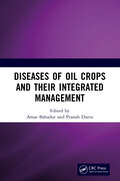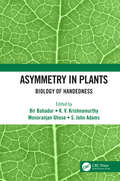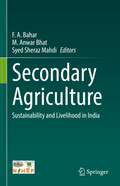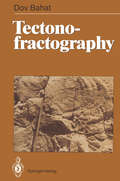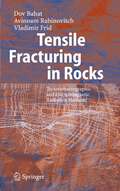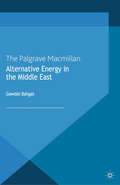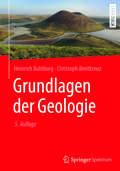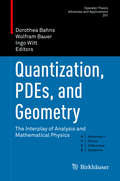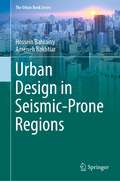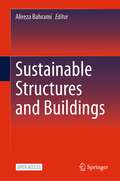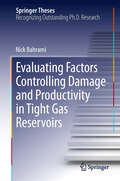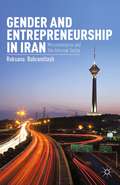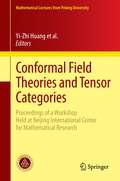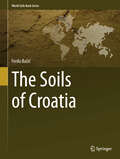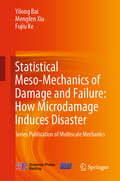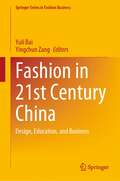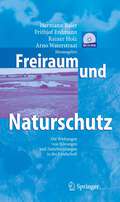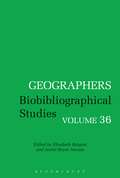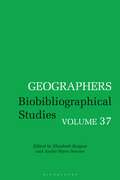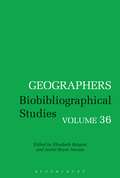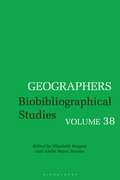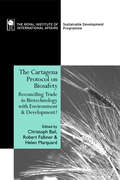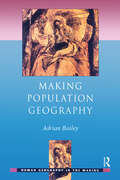- Table View
- List View
Diseases of Oil Crops and Their Integrated Management
by Amar Bahadur Pranab DuttaThis volume compiles information on different aspects of diseases of oil crops and their management. It contains 11 chapters based on different crops contributed by various authors. The book will be helpful for the students pursuing their degree in Agricultural Sciences, growers, teachers, extension personnel, and fellow researchers in their respective fields.
Asymmetry in Plants: Biology of Handedness
by Bir Bahadur K. V. Krishnamurthy Manoranjan Ghose S. John AdamsPlants exhibit forms of asymmetry analogous to "handedness" in bilaterally symmetrical animals. This book explores the evolutionary significance and development of asymmetry. Examples of genetic control include the direction of tendril or stem coiling of many climbing plants; the so-called spiral phyllotaxy and floral taxy; and contorted petal arrangement is another kind of left- right symmetry in plants; the direction of contortion is fixed in some but not in other plants. The book will underscore tha all phenomena related to handedness start during embryogenesis itself, with the occurrence of embryo rotation. Key selling features: First consolidated book on Plant Handedness Relates handedness, asymmetry and chirality to the evolution of different organizational levels in plant biology Emphasizes handedness as a vital governing force in plant functional evolution Provides a new perspective, hitherto ignored, into plant developemtn and evolution Describes how an age-old phenomenon can give scope for investigation from a very modern interdisciplinary approach
Asymmetry in Plants: Biology of Handedness
by Bir Bahadur K. V. Krishnamurthy Monoranjan Ghose S. John AdamsPlants exhibit forms of asymmetry analogous to "handedness" in bilaterally symmetrical animals. This book explores the evolutionary significance and development of asymmetry. Examples of genetic control include the direction of tendril or stem coiling of many climbing plants; the so-called spiral phyllotaxy and floral taxy; and contorted petal arrangement is another kind of left- right symmetry in plants; the direction of contortion is fixed in some but not in other plants. The book will underscore tha all phenomena related to handedness start during embryogenesis itself, with the occurrence of embryo rotation. Key selling features: First consolidated book on Plant Handedness Relates handedness, asymmetry and chirality to the evolution of different organizational levels in plant biology Emphasizes handedness as a vital governing force in plant functional evolution Provides a new perspective, hitherto ignored, into plant developemtn and evolution Describes how an age-old phenomenon can give scope for investigation from a very modern interdisciplinary approach
Secondary Agriculture: Sustainability and Livelihood in India
by F. A. Bahar M. Anwar Bhat Syed Sheraz MahdiThis book on ‘Secondary Agriculture’ discusses the goal of doubling farmers’ incomes. The term ‘secondary’ has a bearing on climate change adaptation and its mitigation, small farm viability and profitability, food security, nutrition, sustainable utilization of natural resources, and optimal usage of produce from primary agriculture and farm incomes. Promoting secondary agriculture has implications on attaining sustainable development goals, which aim to connect primary, secondary and tertiary sectors by using slack/idle factors of production, such as land and labour, contributing to primary agriculture production, capturing ‘value’ in primary agricultural activities, and generating additional income at the enterprise level. In context to same, the chapters of this book have been designed to promote secondary agriculture through low-cost skills and technology applications in agriculture and by upscaling knowledge via integrating primary, secondary and tertiary sectors of agriculture. The motivation behind this book is to address the challenges of biotic and abiotic stresses facing the farming community; to increase farmers income through low-cost skills and technology applications in agriculture; to upscale knowledge by integrating primary, secondary and tertiary sectors of agriculture. The food processing sector in India is still in a nascent stage with only 8 per cent of the produce being processed as against 80-98 per cent in case of high-income countries (Government of India, 2008, 2010). The food processing sector is now receiving the boost with the annual growth of 13.2 per cent in registered food processing units during 2004-10 (Government of India, 2011). Against this backdrop, there is a strong need to strategically handle the situation in order to facilitate a self-sustainable and long-run growth of the sector, which is felt possible by focusing on Secondary Agriculture. Though not a panacea for all ailments of the primary sector, but it can definitely drive the growth.
Tectonofractography
by Dov Bahat" ... he who repeats a thing in the name of him who said it brings deliverance to the world ... " Mishnah, Sayings of the Fathers 6; 6 Main Objectives The present book intends to fulfill a number of purposes, which are arranged under the following scheme: 1. A topical review of main subjects in fractography, that branch of science which analyses fracture surface morphology and related features and their causes and mechanisms in technological materials. Among the materials that bear significant affinities to rock are in organic glass, ceramics, metals and polymer glass. 2. A historical review of the main studies published to date on rock fractography. In both these fields of review, one is confronted by the similarities between small-scale (micro metre) and large-scale (tens of metres) fracture surface morphologies. The similarities, on the one hand, and the differences on the other must surely promote further development of fractographical approaches in structural geology, where extrapola tion from microfractography to large-scale fractography is virtually a directive. As geologists become more familiar with the fractography of rocks, they undoubtedly will become aware of the great power of this descriptive discipline as a tool, in both qualitative and quantitative analysis. Rock fractography must yet be routinely applied in the structural analysis of rock formations in which fracture morphology is sufficiently prominent or extensive.
Tensile Fracturing in Rocks: Tectonofractographic and Electromagnetic Radiation Methods
by Dov Bahat Avinoam Rabinovitch Vladimir Frid‘Tensile Fracturing in Rocks’ presents field observations on fracturing of sedim- tary rocks and granite outcrops from various provinces in three continents. It also combines results of recent experiments conducted at different laboratories around the world with current theories on fracturing. In treating faults, this book limits itself to faults that are associated with joint sets produced by definable causes and occasi- ally to cases where interaction between the two types of fracture – faults and joints – is not clear. The book’s subject matter is divided over six chapters, which are briefly described below. Chapter 1 summarizes current key concepts in fracture physics. It starts with a pr- entation of the elastic theory of fracture, and concentrates on the results of linear el- tic fracture mechanics. The chapter touches also upon other fracture properties, e.g., crack nucleation, dynamic fracturing and slow fracturing processes. Nucleation is - dressed by statistical mechanics methods incorporating modern approaches of th- mal and fiber bundle processes. The analyses of dynamic fracturing and slow fract- ing focus on the differences, as compared to the linear elastic approach. The cont- versy in interpreting experimental dynamic results is highlighted, as are the surface morphology patterns that emerge in fracturing and the non-Griffith crack extension criterion in very slow fracturing processes.
Alternative Energy in the Middle East (Energy, Climate and the Environment)
by G. BahgatThe Middle East region holds the world's largest oil and natural gas proven reserves. Several Middle Eastern States are major oil producers and consumers. Given price fluctuations and environmental concerns many countries have sought to diversify their energy mix. The Middle East is no exception. Gawdat Bahgat analyzes the geopolitical, economic and strategic forces behind this diversification in the Middle East. He highlights the main advantages and disadvantages of each source of energy.
Grundlagen der Geologie
by Heinrich Bahlburg Christoph BreitkreuzFür Studenten der Geologie ein Muss! Im System Erde wirken geologische, geophysikalische, mineralogische, chemische und astronomische Vorgänge und Kräfte zusammen. Für die vierte Auflage haben Heinrich Bahlburg und Christoph Breitkreuz den Inhalt an vielen Stellen überarbeitet und erweitert, v.a. die Abschnitte über Sedimentation und über den Menschen im System Erde - hier sind neue oder erweiterte Abschnitte über Tsunamis und Hurrikane hervorzuheben.
Quantization, PDEs, and Geometry: The Interplay of Analysis and Mathematical Physics (Operator Theory: Advances and Applications #251)
by Dorothea Bahns Wolfram Bauer Ingo WittThis book presents four survey articles on different topics in mathematical analysis that are closely linked to concepts and applications in physics. Specifically, it discusses global aspects of elliptic PDEs, Berezin-Toeplitz quantization, the stability of solitary waves, and sub-Riemannian geometry. The contributions are based on lectures given by distinguished experts at a summer school in Göttingen. The authors explain fundamental concepts and ideas and present them clearly. Starting from basic notions, these course notes take the reader to the point of current research, highlighting new challenges and addressing unsolved problems at the interface between mathematics and physics. All contributions are of interest to researchers in the respective fields, but they are also accessible to graduate students.
Urban Design in Seismic-Prone Regions (The Urban Book Series)
by Hossein Bahrainy Ameneh BakhtiarThis book presents practical guidelines and recommendations for the design in seismic-prone regions. It is based on extensive research and it includes original drawings and sketches at the macro and micro levels. It is the first time that an attempt has been made to publish a book on urban design in the seismic-prone regions, covering the needs of government officials, planners, economists, architects, engineers and scientists, with the purpose of planning for seismic risk reduction and the practical implementation of methodologies and findings in earthquake affected regions. The guidelines presented are expected to be immensely beneficial to all countries in the earthquake prone regions, particularly in the developing world.
Sustainable Structures and Buildings
by Alireza BahramiThis open access book includes detail on various structures, buildings, and building materials from different structural and sustainability perspectives. It describes how the building industry is vital for the achievement of the sustainable development goals, namely, economic growth, social progress, and the effective protection of the environment. The aim of this collection is to foster the design and construction of sustainable structures and buildings to reduce the environmental load, connect with the environment, and benefit the health of occupants. Presenting the knowledge, trends, and developments from a group of contributors in the field working with different kinds of structures, structural components, buildings, and building materials, the book is ideal for practitioners working in commercial settings, as well as engineering students and researchers concerned with sustainability issues.
Evaluating Factors Controlling Damage and Productivity in Tight Gas Reservoirs (Springer Theses)
by Nick BahramiTight gas reservoirs have very low permeability and porosity, which cannot be produced at economical flow rates unless the well is efficiently stimulated and completed using advanced and optimized technologies. Economical production on the basis of tight gas reservoirs is challenging in general, not only due to their very low permeability but also to several different forms of formation damage that can occur during drilling, completion, stimulation, and production operations.This study demonstrates in detail the effects of different well and reservoir static and dynamic parameters that influence damage mechanisms and well productivity in tight gas reservoirs. Geomechanics, petrophysics, production and reservoir engineering expertise for reservoir characterization is combined with a reservoir simulation approach and core analysis experiments to understand the optimum strategy for tight gas development, delivering improved well productivity and gas recovery.
Gender and Entrepreneurship in Iran: Microenterprise and the Informal Sector
by R. BahramitashIran is estimated to have the third largest informal sector in the MENA region a major source of income for many low-income households whose numbers are growing as sanctions tighten. Gender and Entrepreneurship in Iran provides insight into the role of informal networks in employment creation in Iran from a gender perspective. Drawing upon theories of social capital, social network, and the postcolonial feminist critique of mainstream development, this analysis sheds light on the ways in which poverty and unemployment may be tackled.
Conformal Field Theories and Tensor Categories: Proceedings of a Workshop Held at Beijing International Center for Mathematical Research (Mathematical Lectures from Peking University)
by Chengming Bai Jürgen Fuchs Yi-Zhi Huang Liang Kong Ingo Runkel Christoph SchweigertThe present volume is a collection of seven papers that are either based on the talks presented at the workshop "Conformal field theories and tensor categories" held June 13 to June 17, 2011 at theBeijing International Center for Mathematical Research, Peking University, or are extensions of the material presented in the talks at the workshop. These papers present new developments beyond rational conformal field theories and modular tensor categories and new applications in mathematics and physics. The topics covered include tensor categories from representation categories of Hopf algebras, applications of conformal field theories and tensor categories to topological phases and gapped systems, logarithmic conformal field theories and the corresponding non-semisimple tensor categories, and new developments in the representation theory of vertex operator algebras. Some of the papers contain detailed introductory material that is helpful for graduate students and researchers looking for an introduction to these research directions. The papers also discuss exciting recent developments in the area of conformal field theories, tensor categories and their applications and will be extremely useful for researchers working in these areas.
The Soils of Croatia (World Soils Book Series)
by Ferdo BašićThe Soils of Croatia is a six-chapter book detailing all aspects of Croatian soils. The book presents, in a reader friendly way, the lively history of pedology in Croatia. It explains soils as natural resources for this country and offers a detailed view on the different agricultural regions referenced in Croatia. The Soils of Croatia also contains useful information regarding the different factors of soil genesis in the different regions as well as on soil taxonomy and it gives a very detailed classification of different Croatian Soils. Overall, this book contains everything that pedologists, students and anyone else interested in Croatian soils should know about.
Statistical Meso-Mechanics of Damage and Failure: Series Publication of Multiscale Mechanics
by Yilong Bai Mengfen Xia Fujiu KeThis book introduces a trans-scale framework necessary for the physical understanding of breakdown behaviors and presents some new paradigm to clarify the mechanisms underlying the trans-scale processes. The book, which is based on the interaction of mechanics and statistical physics, will help to deepen the understanding of how microdamage induces disaster and benefit the forecasting of the occurrence of catastrophic rupture. It offers notes and problems in each part as interesting background and illustrative exercises.Readers of the book would be graduate students, researchers, engineers working on civil, mechanical and geo-engineering, etc. However, people with various background but interested in disaster reduction and forecasting, like applied physics, geophysics, seismology, etc., may also be interested in the book.
Fashion in 21st Century China: Design, Education, and Business (Springer Series in Fashion Business)
by Yuli Bai Yingchun ZangThis book explores the dynamic landscape of fashion in China since the beginning of the 21st century through an integrated perspective. The book considers key questions related to the changes in China’s fashion dynamics driven largely by the shifts in the mindset of Chinese consumers due to the current sociocultural contexts. To provide an understanding of these important shifts, this three-part monograph pays close attention to the new generation of Chinese fashion designers and consumers. The book explores in detail related topics such as, how today’s Chinese consumers relate to foreign brands, the meaning of apparel brands as identity symbols or cultural signs to contemporary young consumers, the attractiveness of Western fashion designers and brands in the eyes of current Chinese consumers as compared to past consumers, and how brands could adapt to the online-centered consumption behavior. The book serves as an insightful update on the Chinese fashion landscape for researchers, practitioners and passionate followers of its evolution.
Freiraum und Naturschutz: Die Wirkungen von Störungen und Zerschneidungen in der Landschaft
by Hermann Baier Frithjof Erdmann Rainer Holz Arno WaterstraatFlächenverbrauch sowie Störungen und Zerschneidungen in der Landschaft führen für viele Tier- und Pflanzenarten zu einschneidenden Konsequenzen. Erhöhte Mortalität, Dezimierung von Lebensräumen, verringerter Genaustausch und Verinselung der Restpopulationen erfordern eine weit über die einzelne Population oder den einzelnen Biotop hinausgehende Betrachtungsweise. Durch Verknüpfung von geographischen, verhaltensbiologischen und populationsökologischen Ansätzen wird hier erstmals ein geschlossener Überblick über das Thema vorgelegt. Anhand von Beispielen werden die Einflüsse von Störungen und in den einzelnen Wirkebenen wie Verhalten, Habitatnutzung und Population erläutert. Schlussfolgerungen für die Umwelt-, Landschaftsplanung, den Artenschutz und die Eingriffsregelung bieten neben der Vermittlung eines in sich geschlossenen Theoriegebäudes auch dem Praktiker im Naturschutz eine wertvolle Hilfe für die tägliche Arbeit.
Geographers: Biobibliographical Studies, Volume 36 (Geographers)
by Elizabeth Baigent André Reyes NovaesGeographers: Biobibliographical Studies, Volume 36 focuses on 20th-century Britain and 19th- and 20th-century France. Six essays on individual geographers are complemented by a group article which describes the building of a French school of geography. From Britain, the life of Sir Peter Hall, one of the most distinguished geographers of recent times and a man widely known outside the discipline, is set alongside memoirs of Bill Mead, who made the rich geography of the Nordic countries come alive to geographers and others in the Anglophone world; Michael John Wise and Stanley Henry Beaver, who made their mark through building up the institutions where academic geography was practised and through teaching; and Anita McConnell, whose geographical training shaped her museum curation and studies of the history of science. From France, the individual biography of André Meynier is juxtaposed with group article on the first five professors of geography at Clermont-Ferrand. These intellectual biographies collectively show geography and geographers profoundly affected by wider historical events: the effect of war, particularly the Second World War, and the shaping of post-war society. They show the value of geographical scholarship in elucidating local circumstances and in planning national conditions, and as a basis for local, national, and international friendship.
Geographers: Biobibliographical Studies, Volume 37 (Geographers)
by Elizabeth Baigent André Reyes NovaesGeographers: Biobibliographical Studies, Volume 37 explores the concept of distinction in geography. Through the lives of six geographers working in Brazil and Réunion, it investigates what distinction consists of, how we identify and celebrate it and how it relates to quotidian practices in the discipline.The volume highlights the continuing importance of biography and the International Geographical Union in recording and assessing distinction. It also considers the relevance of personal networks for the circulation and translation of distinguished geographical knowledge, and how this knowledge can underpin applied projects and critical appraisal of geographical scholarship, both at a national and sub-national level. Gendered notions of distinction are also addressed, particularly through June Sheppard, who found limited recognition for her work as a result of gendered expectations within the discipline and society at large.By reflecting on how we locate distinguished geographers and tell their histories, Geographers: Biobibliographical Studies, Volume 37 makes an important contribution to fostering less canonical work in historical geography.
Geographers: Biobibliographical Studies, Volume 36 (Geographers #Volume 28)
by Elizabeth Baigent André Reyes NovaesGeographers: Biobibliographical Studies, Volume 36 focuses on 20th-century Britain and 19th- and 20th-century France. Six essays on individual geographers are complemented by a group article which describes the building of a French school of geography. From Britain, the life of Sir Peter Hall, one of the most distinguished geographers of recent times and a man widely known outside the discipline, is set alongside memoirs of Bill Mead, who made the rich geography of the Nordic countries come alive to geographers and others in the Anglophone world; Michael John Wise and Stanley Henry Beaver, who made their mark through building up the institutions where academic geography was practised and through teaching; and Anita McConnell, whose geographical training shaped her museum curation and studies of the history of science. From France, the individual biography of André Meynier is juxtaposed with group article on the first five professors of geography at Clermont-Ferrand. These intellectual biographies collectively show geography and geographers profoundly affected by wider historical events: the effect of war, particularly the Second World War, and the shaping of post-war society. They show the value of geographical scholarship in elucidating local circumstances and in planning national conditions, and as a basis for local, national, and international friendship.
Geographers: Biobibliographical Studies, Volume 37 (Geographers #Volume 28)
by Elizabeth Baigent André Reyes NovaesGeographers: Biobibliographical Studies, Volume 37 explores the concept of distinction in geography. Through the lives of six geographers working in Brazil, North America, Europe and Réunion, it investigates what distinction consists of, how we identify and celebrate it and how it relates to quotidian practices in the discipline.The volume highlights the continuing importance of biography and the International Geographical Union in recording and assessing distinction. It also considers the relevance of personal networks for the circulation and translation of distinguished geographical knowledge, and how this knowledge can underpin applied projects and critical appraisal of geographical scholarship, both at a national and sub-national level. Gendered notions of distinction are also addressed, particularly through June Sheppard, who found limited recognition for her work as a result of gendered expectations within the discipline and society at large.By reflecting on how we locate distinguished geographers and tell their histories, Geographers: Biobibliographical Studies, Volume 37 makes an important contribution to fostering less canonical work in historical geography.
Geographers: Biobibliographical Studies, Volume 38 (Geographers #Volume 28)
by Elizabeth Baigent André Reyes NovaesWomen are the exclusive focus of the 38th volume of Geographers. For the first time in the serial's history, the entire volume is devoted to important work of distinguished female geographers, amply demonstrating how these scholars' professional lives enrich the discipline's history. It also illustrates how reading and writing their biographies not only expands our understanding of geography's past, but points to its more diverse future.The collection includes biographies of Doreen Massey, winner of geography's 'Nobel prize', the prix Vautrin-Lud, for her remarkable contribution to geography and neighbouring disciplines which discovered the importance of space through her work; Helen Wallis, geographer and historian of cartography who for many years had charge of the UK's foremost collection of maps; Alice Saunier-Seïté, who applied her geographical training and formidable energy to teaching and educational reform in France; Isabel Margarida André, who lived through a turbulent political period in her native Portugal and meticulously investigated its effect on women and political geography; and the many women who helped to create the UK's first Geography department - the University of Oxford's, School of Geography - including Fanny Herbertson, Nora MacMunn, Marjorie Sweeting, Mary Marshall, Barbara Kennedy and other women geographers who are memorialised in a group article.
The Cartagena Protocol on Biosafety: Reconciling Trade in Biotechnology with Environment and Development
by Christoph Bail Robert Falkner Helen MarquardModern biotechnology - the controversial manipulation of genes in living organisms - has far-reaching implications for agriculture, human health, trade and the environment. Against the odds, an international treaty governing biosafety and trade in biotechnology was adopted in 2000. The Cartagena Protocol on Biosafety of the Convention on Biological Diversity deals with one of the most important and challenging issues thrown up by developments in biotechnology. This volume is a comprehensive review of the protocol and the process that led to its adoption. It includes contributions from many of the key players involved and analyses the commercial and political interests at stake, the operations and implications of the protocol, and prospects for the future.
Making Population Geography
by Adrian BaileyMaking Population Geography is a lively account of the intellectual history of population geography, arguing that, while population geography may drift in and out of fashion, it must continue to supplement its demographic approach with a renewed emphasis on cultural and political accounts of compelling population topics, such as HIV-AIDS, sex trafficking, teen pregnancy, citizenship and global ageing, in order for it to shed light on contemporary society. Making Population Geography draws both on the writings of those like Wilbur Zelinsky and Pat Gober who were at the very epicentre of spatial science in the 1960s and those like Michael Brown and Yvonne Underhill-Sem whose post-punk introspections of method, content and purpose, now push the field in new directions. Using a wide range of case studies, contemporary examples and current research, the book links the rise and fall of the key concepts in population geography to the changing social and economic context and to geographys turn towards social theory. Referencing the authors classroom experiences both in the US and the UK, Making Population Geography will appeal to students studying geography, population issues and the development of critical scholarship.
